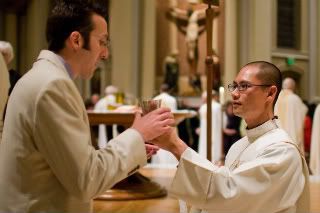 Bishop Patrick J. McGrath has asked all the parishes of the diocese of San Jose to offer the Communion cup to all the faithful at Mass, especially at Sunday and feast day Masses. By asking parishes to follow this policy, Bishop McGrath is highlighting the directive of the General Instruction of the Roman Missal (GIRM), which has been in place since 1970:
Bishop Patrick J. McGrath has asked all the parishes of the diocese of San Jose to offer the Communion cup to all the faithful at Mass, especially at Sunday and feast day Masses. By asking parishes to follow this policy, Bishop McGrath is highlighting the directive of the General Instruction of the Roman Missal (GIRM), which has been in place since 1970:Holy Communion has a fuller form as a sign when it is distributed under both kinds. For in this form the sign of the Eucharistic banquet is more clearly evident and clear expression is given to the divine will by which the new and eternal Covenant is ratified in the Blood of the Lord…. (281)
Since the 16th century and the Council of Trent, the church has taught that Christ, whole and entire, is present in the consecrated bread, and if we receive only the Body of Christ, we receive the full grace of the sacrament. So why bother receiving from the cup?
The most important reason is that Jesus told us to. At every Eucharist, the presider repeats the command Jesus gave to us at the last supper:
Take this, all of you, and drink from it:
this is the cup of my blood,
the blood of the new and everlasting covenant.
It will be shed for you and for all
so that sins may be forgiven.
Do this in memory of me.
Yet if Jesus gave us the sign of bread, why would he also direct us to take and drink from the cup? The GIRM gives us a clue. Something is made more clear, more evident when we drink from the cup. So then, what is more clear when we receive Christ’s Blood? And to whom is this evident?
What it means when we drink from the cup
Rev. Paul Bernier, SSS, says that what is clear from partaking of Christ’s Body is that we become members of that same body, here on earth. What becomes clear when we receive Christ’s Blood is how we will become one body.
It is only by pouring out our blood, our lives for others in the same way that Jesus did, that we can be true to our calling. Receiving from the cup is more than a reduplication of Communion under the form of bread, and far more than an empty ritual. It reminds us that Jesus’ own self-offering, his shedding his blood on the cross, is what brought about our salvation. Only the same gift of self to God will make us pleasing to him and enable us to be instruments of God’s life to others. (This Sunday’s Scripture)
In other words, what becomes clear in drinking from the cup of Christ’s Blood is the shedding of blood—Christ’s blood on the cross and our own blood, poured out in imitation of his great sacrifice.
Who drinking from the cup teaches
The call to sacrifice is first of all made more clear to those who participate in the sacrifice—the baptized faithful. As the church tells us, the sign is fuller and more complete when we share in both the Body and Blood of Christ, and, therefore, we receive a strong reminder of our baptismal promise to die to ourselves each time we drink from the cup.
But more importantly, the call to sacrifice becomes clearer to the children and the catechumens—those who are only beginning to understand the call to sacrifice. Our participation in the cup of salvation is an ongoing catechesis to those who are new to the faith about what faith requires—the shedding of blood.
We become what we eat—and drink
If Mass were only about receiving grace, then partaking only of the Body of Christ would surely be sufficient. But Eucharist is about much more than that. It is also about the reason we receive grace—to go in peace to love and serve the Lord. That service includes sacrifice, and the cup of salvation teaches us and those around us what that sacrifice ultimately demands. It demands that we proclaim the death of the Lord by becoming one with Christ’s Body—and his Blood.
No comments:
Post a Comment